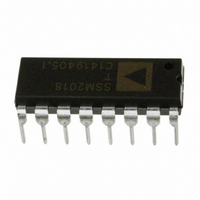SSM2018TPZ Analog Devices Inc, SSM2018TPZ Datasheet - Page 12

SSM2018TPZ
Manufacturer Part Number
SSM2018TPZ
Description
IC AMP AUDIO MONO CLASS AB 16DIP
Manufacturer
Analog Devices Inc
Datasheet
1.SSM2018PZ.pdf
(16 pages)
Specifications of SSM2018TPZ
Amplifier Type
Audio
Number Of Circuits
1
Slew Rate
5 V/µs
Gain Bandwidth Product
14MHz
Current - Input Bias
250nA
Voltage - Input Offset
1000µV
Current - Supply
11mA
Voltage - Supply, Single/dual (±)
10 V ~ 36 V, ±5 V ~ 18 V
Operating Temperature
-40°C ~ 85°C
Mounting Type
Through Hole
Package / Case
16-DIP (0.300", 7.62mm)
Amplifier Class
AB
No. Of Channels
1
Supply Voltage Range
± 5V To ± 18V
Load Impedance
100kohm
Operating Temperature Range
-40°C To +85°C
Amplifier Case Style
DIP
No. Of Pins
16
Rohs Compliant
Yes
Lead Free Status / RoHS Status
Lead free / RoHS Compliant
Output Type
-
Current - Output / Channel
-
-3db Bandwidth
-
Available stocks
Company
Part Number
Manufacturer
Quantity
Price
Company:
Part Number:
SSM2018TPZ
Manufacturer:
MICREL
Quantity:
12 500
SSM2018T
If a symmetry trim is to be performed, it should precede the
control feedthrough trim and be done as follows:
1. Apply a 1 kHz sine wave of 10 dBu to the input with the
2. Adjust the symmetry trim potentiometer to minimize distor-
Next the control feedthrough trim is done as follows:
1. Ground the input signal port and apply a 60 Hz sine wave
2. Adjust the control feedthrough potentiometer to null the
100k
control voltage set for unity gain.
tion of the output signal.
to the control port. The sine wave should have its high and
low peaks correspond to the highest gain to be used in the
application and 30 dB of attenuation, respectively. For
example, a range of 20 dB gain to 30 dB attenuation requires
that the sine wave amplitude ranges between –560 mV and
+840 mV on Pin 11.
signal seen at the output.
V–
V+
INPUTS
CONTROL
FEEDTHROUGH
TRIM
10M
Figure 7. OVCE Follower/VCA Connection
V
IN
Figure 8. OVCE Application Circuit
500k
220pF
V+
SYMMETRY
TRIM
R
NC = NO CONNECT
1
2
3
4
5
6
7
8
B
: 30k
150k
SSM2018T
50pF
18k
18k
FOR CLASS A
50pF
FOR CLASS AB
V
C
470k
16
15
13
12
10
14
11
9
NC
V–
R
B
1 F
V
V
V+
1–G
G
V
V
G
1–G
1k
3k
V
CONTROL
–12–
Voltage Controlled Panner
An interesting circuit that is built with the OVCE building
block is a voltage controlled panner. Figure 9 shows the feed-
back connection for the circuit. Notice that the average of both
outputs is fed back to the input. Thus, the average must be
equal to the input voltage. When the control voltage is set for
gain at V
same). On the other hand, when V
fied. The result is that the control voltage causes the input to
“pan” from one output to the other. The following expressions
show how this circuit works mathematically:
where K varies between 0 and 1 as the control voltage is changed
from full attenuation to full gain, respectively. When V
then K = 0.5 and V
for best performance. Pin 9 must be grounded. This is possible
because the feedback is constant and the adaptive network is not
needed. The VCP is the only application shown in this data
sheet where Pin 9 is grounded.
V
G
= 2 K ¥V
V
G
IN
, this causes V
Figure 9. Basic VCP Connection
IN
and V
G
= V
1–G
18k
18k
1–G
I –G
to attenuate (to keep the average the
= V
V
= 2 (1 – K ) ¥V
C
IN
G
. Again, trimming is required
is attenuated, V
IN
V
V
1–G
G
1–G
C
is ampli-
= 0,
REV. B
(4)









